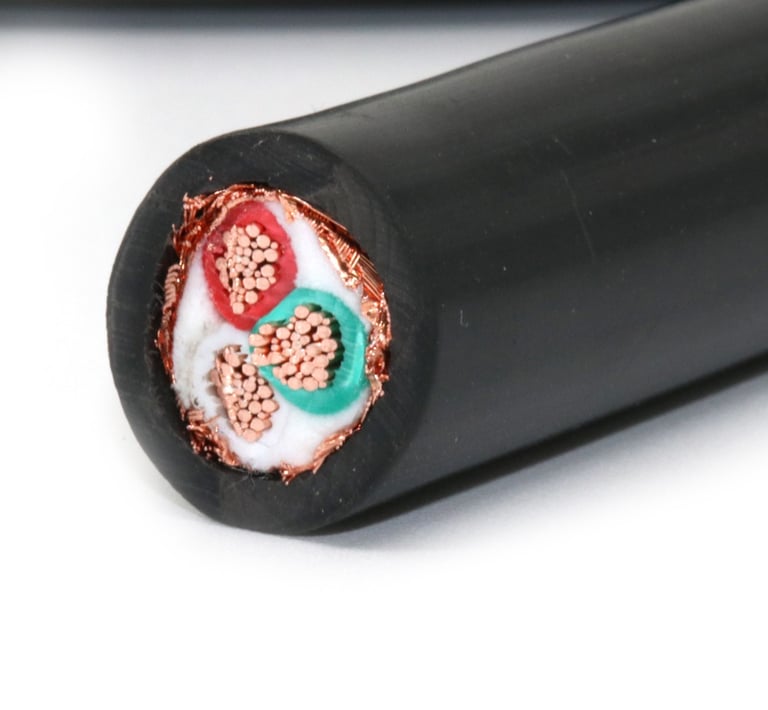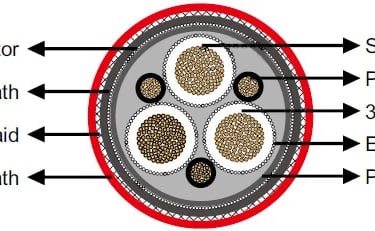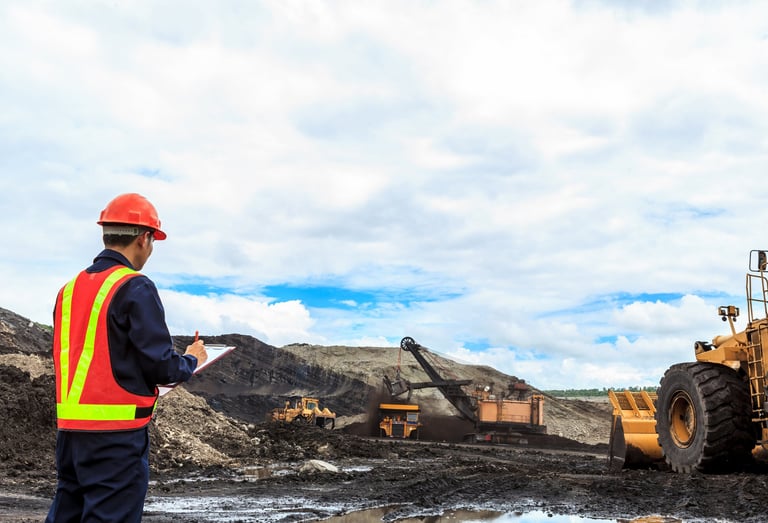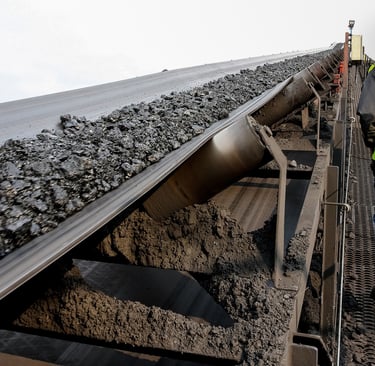Anhui Feichun Special Cable Co.,Ltd Li.wang@feichuncables.com
How to Identify and Resolve Mining Cable Cross-Section Distortion?
Learn how to identify and resolve mining cable cross-section distortion with expert guidance on causes, detection methods, and prevention strategies for South African mining operations.
Li.wang@Feichun Cable
7/21/202513 min read


Mining operations across South Africa face numerous challenges when it comes to maintaining reliable electrical infrastructure. From the platinum mines of the Bushveld Complex to the gold operations in Gauteng, cable failures can result in costly downtime, safety hazards, and production losses. One of the most insidious problems affecting mining cables is cross-section distortion – a condition where the circular cross-section of a cable becomes deformed, leading to reduced performance and potential failure.
Cross-section distortion in mining cables is more than just a cosmetic issue. It represents a fundamental compromise to the cable's electrical and mechanical integrity, affecting everything from current-carrying capacity to insulation performance. With South Africa's mining sector contributing significantly to the country's economy, understanding how to identify and resolve cable cross-section distortion is crucial for maintaining safe and efficient operations.
This comprehensive guide explores the causes, identification methods, and resolution strategies for mining cable cross-section distortion, with specific focus on South African mining conditions and regulatory requirements. Whether you're managing underground operations or open-pit facilities, the insights provided here will help you maintain optimal cable performance and prevent costly failures.
What Causes Cross-Section Distortion in Mining Cables?
Understanding the root causes of cross-section distortion is essential for effective prevention and resolution. In South African mining environments, several factors contribute to this problem, often working in combination to compromise cable integrity.
Mechanical Stress and Physical Forces
Mechanical stress represents the primary cause of cross-section distortion in mining cables. This stress manifests in various forms throughout the cable's operational life. Bending forces occur when cables are routed around tight corners or through confined spaces, particularly common in underground mining operations where space is at a premium. Pulling forces during installation can exceed the cable's design limits, especially when installers attempt to thread heavy cables through narrow conduits or around obstacles.
Crushing forces present perhaps the greatest threat to cable cross-sectional integrity. In mining environments, cables often experience compression from heavy equipment, falling debris, or improper storage. The recent incidents at several Witwatersrand gold mines highlight how equipment traffic over improperly protected cables can cause significant distortion, leading to electrical faults and production delays.
Thermal Cycling Effects
South African mining operations often involve extreme temperature variations, creating thermal cycling conditions that contribute to cable distortion. High-power electrical systems generate significant heat, causing cables to expand during operation and contract during downtime. This repeated expansion and contraction cycle gradually weakens the cable structure and can lead to permanent deformation.
Underground mining operations in the Northern Cape and Free State provinces experience particularly challenging thermal conditions. The combination of geothermal heating from deep excavations and heat generated by high-power mining equipment creates environments where cables operate at elevated temperatures for extended periods. When these hot cables encounter cooler sections of the mine or experience rapid cooling during equipment shutdowns, thermal shock can accelerate cross-sectional distortion.
Inadequate Support Systems
Proper cable support is crucial for preventing cross-section distortion, yet many mining operations still rely on outdated or inadequate support systems. Mobile equipment such as continuous miners, load-haul-dump (LHD) units, and conveyor systems require sophisticated cable management systems to prevent distortion during operation.
The reeling systems used in many South African mines present particular challenges. Cables that wind and unwind repeatedly on reels experience cyclic stress that can gradually alter their cross-sectional shape. Without proper tensioning and support mechanisms, these cables develop flat spots or oval deformations that compromise their electrical performance.
Material Fatigue and Ageing
Cable materials naturally degrade over time, becoming more susceptible to cross-section distortion as they age. The harsh conditions typical in South African mining accelerate this ageing process. Exposure to moisture, chemicals, abrasive particles, and temperature extremes all contribute to material fatigue that makes cables more vulnerable to deformation.
Older installations using outdated cable designs or materials may lack the flexibility and durability of modern mining cables. As these cables approach or exceed their design life, they become increasingly prone to distortion under normal operating stresses.
Manufacturing and Installation Defects
Poor manufacturing practices or installation errors can predispose cables to cross-section distortion. Manufacturing defects might include uneven conductor placement, inadequate insulation thickness, or improper curing of cable sheath materials. These defects create weak points that are more susceptible to deformation under operational stresses.
Installation practices significantly impact cable performance and longevity. Improper handling during installation, such as exceeding minimum bend radius requirements or using excessive pulling forces, can cause immediate distortion or create conditions that lead to future deformation. Training deficiencies among installation crews often contribute to these problems, particularly when dealing with specialized mining cable requirements.
How to Identify Cross-Section Distortion?
Early identification of cross-section distortion is crucial for preventing cable failures and maintaining mining operations. A comprehensive approach combining visual inspection, advanced testing methods, and monitoring technologies provides the most effective detection strategy.
Visual Inspection Techniques
Visual inspection remains the first line of defence against cable distortion problems. Trained personnel can identify many distortion issues through careful observation of cable appearance and condition. Key visual indicators include obvious flattening of the cable cross-section, where the normally circular profile appears compressed or oval-shaped. This flattening is particularly evident when comparing the cable to undamaged sections or reference standards.
Bulges and ridges on the cable sheath indicate internal distortion or damage to the cable structure. These irregularities often appear at stress concentration points such as cable terminations, support clamps, or areas where the cable changes direction. Surface deformations may also indicate conductor movement within the cable, a serious condition that requires immediate attention.
Color changes or surface marking can reveal areas where the cable has experienced excessive stress or heat exposure. Discoloration, particularly darkening of the cable sheath, often accompanies cross-section distortion and suggests thermal damage or accelerated ageing.
Thermal Imaging Assessment
Thermal imaging technology provides valuable insights into cable condition and performance, particularly for identifying the thermal consequences of cross-section distortion. Infrared cameras can detect localized hot spots that indicate uneven current distribution caused by conductor deformation or damage.
Distorted cables often exhibit non-uniform temperature profiles, with certain areas running significantly hotter than others. This thermal imbalance indicates reduced cross-sectional area in the hottest regions, confirming the presence of distortion and helping locate the most severely affected areas.
Regular thermal surveys should be incorporated into mining facility maintenance programs, particularly for high-current applications such as main distribution feeders, motor circuits, and heavy equipment power supplies. The relatively non-intrusive nature of thermal imaging makes it ideal for monitoring cables in operational mining environments.
Electrical Testing Methods
Electrical testing provides quantitative assessment of cable condition and can detect distortion-related problems that may not be visible during external inspection. Voltage drop measurements across cable runs can reveal increased resistance caused by reduced conductor cross-sectional area. Comparing measured voltage drops to baseline values or theoretical calculations helps identify problem areas.
Insulation resistance testing detects deterioration in cable insulation that often accompanies cross-section distortion. Distorted cables frequently experience insulation damage as conductors shift position or as mechanical stress creates micro-fractures in insulating materials. Regular insulation resistance testing using appropriate test voltages can identify these problems before they lead to failures.
Power factor testing provides additional insight into cable condition, particularly for higher voltage applications. Changes in power factor measurements can indicate insulation deterioration or internal structural changes associated with cross-section distortion.
Advanced Diagnostic Techniques
For high-value installations or inaccessible cable runs, advanced diagnostic techniques provide detailed information about cable condition. X-ray analysis can reveal internal cable structure and identify conductor displacement, insulation damage, or other structural problems associated with distortion.
Ultrasonic testing techniques can detect internal voids, delamination, or other structural defects that may not be apparent through external inspection. These techniques are particularly valuable for assessing buried cables or installations where access is limited.
Partial discharge testing can identify insulation problems associated with cable distortion, particularly in higher voltage applications. This technique detects electrical discharges within the cable insulation that often precede complete insulation failure.
Effects of Cable Cross-Section Distortion
Cross-section distortion creates a cascade of problems that affect both immediate cable performance and long-term reliability. Understanding these effects helps prioritize maintenance actions and justify investment in prevention programs.
Current-Carrying Capacity Reduction
Cross-section distortion directly impacts a cable's ability to carry its rated current safely. When the circular cross-section becomes flattened or deformed, the effective conductor area decreases, increasing electrical resistance and reducing current-carrying capacity. This reduction in ampacity can force operations to reduce electrical loads or risk overheating and failure.
The relationship between cross-sectional area and current-carrying capacity is not linear, meaning even modest distortion can significantly impact cable performance. A 10% reduction in cross-sectional area might result in a 15-20% reduction in safe current-carrying capacity, depending on the specific cable design and operating conditions.
Thermal Management Challenges
Distorted cables exhibit poor thermal performance due to uneven current distribution and reduced heat dissipation capability. The deformed cross-section creates current concentration in the remaining undamaged conductor areas, leading to localized heating that exceeds design temperatures.
Additionally, distortion often compromises the cable's thermal dissipation properties. The normally optimized spacing between conductors and the circular geometry that promotes even heat distribution become compromised, reducing the cable's ability to dissipate heat effectively. This thermal imbalance accelerates insulation ageing and increases the risk of thermal failure.
Insulation System Compromise
Cross-section distortion places mechanical stress on the cable's insulation system, often leading to premature failure. As conductors shift position within the distorted cable, they may contact each other or approach the cable sheath more closely than designed, reducing insulation distances and increasing the risk of electrical faults.
The mechanical deformation associated with distortion can create micro-cracks in insulation materials, providing pathways for moisture ingress and reducing dielectric strength. In mining environments where cables are exposed to moisture, dust, and chemical contaminants, these insulation compromises can quickly lead to catastrophic failures.
Mechanical Integrity Loss
Distorted cables lose mechanical strength and become more susceptible to additional damage. The structural changes that cause cross-section distortion often weaken the cable's overall construction, making it vulnerable to further mechanical stress, vibration, or environmental exposure.
This reduced mechanical integrity is particularly problematic in mining applications where cables must withstand significant mechanical stresses during normal operation. Mobile equipment cables, in particular, rely on structural integrity to survive repeated flexing, tension, and compression cycles.
Regulatory Compliance Issues
Cross-section distortion can compromise compliance with South African safety standards, particularly SANS 1520-1, which specifies requirements for mining cables. Non-compliant installations may face regulatory scrutiny and require immediate remediation to maintain operating permits.
Insurance implications also arise when cable installations fail to meet applicable standards or manufacturer specifications. Distortion-related failures may not be covered under warranty or insurance policies if the distortion results from improper installation or maintenance practices.
How to Resolve Cross-Section Distortion
Addressing cross-section distortion requires a systematic approach that considers the severity of the distortion, the criticality of the affected circuit, and the available resources. Resolution strategies range from immediate replacement to preventive measures that address underlying causes.
Assessment and Prioritization
The first step in resolving cross-section distortion involves thorough assessment of the affected cables and prioritization of remedial actions. Critical circuits that support essential mining operations or safety systems require immediate attention, while less critical applications may allow for planned maintenance approaches.
Assessment should include documentation of distortion severity, measurement of electrical parameters, and evaluation of safety implications. This information guides decisions about whether immediate replacement is necessary or whether temporary measures can provide adequate safety until planned maintenance can be performed.
Cable Replacement Strategies
Severely distorted cables typically require complete replacement to restore full performance and reliability. Replacement planning should consider not only the immediate cable needs but also the underlying causes that led to distortion. Simply replacing cables without addressing root causes often leads to repeated failures.
When selecting replacement cables, consideration should be given to upgraded designs that better suit the actual operating conditions. Modern mining cables often incorporate improved materials and construction techniques that provide better resistance to the mechanical and thermal stresses that cause distortion.
Replacement procedures should follow established industry practices, including proper handling techniques, appropriate installation tools, and verification testing to ensure the new installation meets performance requirements. Documentation of replacement activities provides valuable information for future maintenance planning.
Cable Reconditioning Options
In some cases, cables with minor distortion may be reconditioned rather than replaced. Reconditioning typically involves careful removal of the cable from service, assessment of the distortion extent, and restoration of proper cross-sectional shape where possible.
Reconditioning is most successful when distortion is limited to localized areas and when the underlying cable structure remains intact. Specialized tools and techniques may be required to restore proper cable geometry without causing additional damage to conductors or insulation.
The decision to recondition rather than replace should consider the cable's age, service history, and criticality of application. Reconditioned cables may not achieve the full performance and reliability of new installations, making replacement the preferred option for critical applications.
Installation Improvements
Addressing the installation factors that contributed to distortion is essential for preventing recurrence. This may involve redesigning cable support systems, improving cable routing to reduce mechanical stress, or implementing better protection measures in areas where cables are exposed to mechanical hazards.
Support system improvements might include installing additional cable clamps, upgrading to load-distributing support hardware, or implementing cable tray systems that provide better mechanical protection. For mobile equipment applications, improved reeling systems with better tension control and guide mechanisms can significantly reduce distortion risks.
Preventive Maintenance Integration
Resolution of cross-section distortion should be integrated into comprehensive preventive maintenance programs that address the underlying causes and monitor for early signs of future problems. Regular inspection schedules, electrical testing protocols, and thermal monitoring programs provide early warning of developing issues.
Training programs for maintenance personnel should emphasize recognition of distortion warning signs and proper remedial procedures. Well-trained maintenance teams can identify and address minor problems before they develop into major failures requiring extensive downtime and replacement costs.
Best Practices for Prevention
Preventing cross-section distortion requires a proactive approach that addresses potential causes throughout the cable lifecycle, from initial design and installation through ongoing operation and maintenance.
Personnel Training and Competency
Comprehensive training programs for personnel involved in cable installation, maintenance, and operation form the foundation of effective distortion prevention. Training should cover proper handling techniques, installation procedures, and recognition of conditions that contribute to cable distortion.
Installation crews should understand the importance of respecting minimum bend radius requirements, proper pulling techniques, and appropriate use of installation tools. Maintenance personnel need training in inspection techniques, electrical testing procedures, and assessment of cable condition indicators.
Ongoing competency assessment ensures that personnel maintain current knowledge of best practices and emerging technologies. Regular refresher training and updates on new cable technologies and installation techniques keep personnel current with industry developments.
Mechanical Stress Management
Effective management of mechanical stresses requires careful attention to cable routing, support systems, and protection measures. Cable routes should minimize sharp bends, avoid areas of high mechanical stress, and provide adequate clearance from moving equipment and potential impact sources.
Support systems should distribute mechanical loads evenly along the cable length, avoiding point loads that can cause localized distortion. Load-distributing clamps, properly spaced cable supports, and appropriate support materials all contribute to stress reduction.
Protection measures such as cable guards, barriers, and warning systems help prevent accidental damage from mobile equipment or falling objects. In high-traffic areas, physical barriers or elevated cable routing may be necessary to prevent mechanical damage.
Environmental Control Measures
Managing environmental factors that contribute to cable distortion involves both design considerations and operational practices. Temperature control measures may include ventilation systems, heat shielding, or thermal barriers that reduce thermal cycling effects.
Moisture control through proper sealing, drainage, and environmental protection helps prevent accelerated material degradation that increases distortion susceptibility. Chemical exposure controls, including appropriate cable selection and protective measures, address the aggressive chemical environments common in mining operations.
Monitoring and Inspection Programs
Regular monitoring and inspection programs provide early detection of developing problems and enable preventive intervention before distortion becomes severe. Visual inspection protocols should be established for all cable installations, with frequency based on criticality and operating conditions.
Electrical testing programs should include regular measurement of insulation resistance, voltage drop, and other parameters that indicate cable condition. Thermal monitoring using infrared cameras can detect developing hot spots that indicate current distribution problems associated with distortion.
Documentation systems should track inspection results, test measurements, and maintenance actions to identify trends and guide preventive maintenance decisions. Data analysis can reveal patterns that help optimize inspection frequencies and identify high-risk installations.
Frequently Asked Questions (FAQ)
Q1: What's the most common cause of cross-section distortion?
Mechanical stress, particularly crushing and bending forces during installation and operation, represents the primary cause of cross-section distortion in mining cables. Poor handling practices during installation account for many distortion problems, especially when installation crews exceed the cable's minimum bend radius or apply excessive pulling forces. In operational environments, inadequate protection from mobile equipment traffic and insufficient cable support systems contribute significantly to mechanical stress-induced distortion.
Q2: Can a distorted cable still function safely?
While distorted cables may continue to carry electrical current, they operate with compromised safety margins and reduced reliability. Minor distortion might not cause immediate failure, but it typically leads to increased operating temperatures, reduced current-carrying capacity, and accelerated insulation ageing. The electrical performance degradation associated with distortion creates conditions that increase the risk of overheating, insulation failure, or electrical faults. From a safety perspective, any noticeable distortion should be evaluated by qualified personnel to assess the risks and determine appropriate remedial action.
Q3: How often should mining cables be inspected for distortion?
Inspection frequency depends on the specific application, operating environment, and cable criticality. High-motion applications such as mobile equipment cables require more frequent inspection, typically during routine maintenance cycles or monthly visual inspections. Fixed installations in stable environments may be inspected quarterly or semi-annually. Critical circuits supporting essential operations or safety systems warrant more frequent monitoring, potentially including continuous thermal monitoring in addition to periodic physical inspections. Environmental factors such as exposure to mechanical hazards, temperature extremes, or chemical contamination may necessitate more frequent inspections regardless of application type.
Q4: Are all distorted cables dangerous?
Not all cable distortions present immediate safety hazards, but any visible deformation indicates some level of compromise to the cable's integrity. Minor distortions in non-critical applications may be acceptable with increased monitoring and planned replacement during routine maintenance cycles. However, significant distortion, distortion in critical circuits, or distortion accompanied by other symptoms such as overheating or insulation damage requires immediate attention. The assessment of distortion severity and associated risks should always be performed by qualified personnel with appropriate testing equipment and knowledge of applicable safety standards.
Q5: Is cross-section distortion covered under warranty or certification standards?
Most cable manufacturers' warranties require that cables be installed and operated within specified parameters, including mechanical stress limitations, environmental conditions, and proper handling procedures. Distortion resulting from improper installation, excessive mechanical stress, or operation outside specified parameters may void warranty coverage. South African standards such as SANS 1520-1 specify performance requirements that distorted cables may not meet, potentially affecting regulatory compliance. However, distortion resulting from manufacturing defects or materials that fail to meet specified performance criteria would typically be covered under warranty provisions. Proper documentation of installation procedures, operating conditions, and maintenance practices helps establish whether distortion results from covered defects or excluded installation and operational factors.
Conclusion
Cross-section distortion in mining cables represents a significant threat to operational reliability, safety, and economic performance in South Africa's mining sector. The complex interplay of mechanical stresses, thermal cycling, environmental factors, and installation practices creates conditions where cable distortion can develop and compromise electrical system performance.
Understanding the causes of cross-section distortion enables mining operations to implement effective prevention strategies that address root causes rather than simply treating symptoms. Proper installation techniques, adequate support systems, environmental controls, and comprehensive training programs form the foundation of successful distortion prevention.
Early detection through systematic inspection and testing programs allows for timely intervention before distortion leads to cable failure and costly downtime. The combination of visual inspection, thermal monitoring, electrical testing, and advanced diagnostic techniques provides comprehensive assessment capabilities that support informed maintenance decisions.
Resolution strategies must address both immediate safety concerns and long-term reliability requirements. While cable replacement often provides the most reliable solution for severely distorted cables, prevention measures and improved installation practices offer the most cost-effective approach to managing distortion risks.
The economic impact of cable failures in mining operations extends far beyond the immediate replacement costs to include production losses, safety risks, and regulatory compliance issues. Investment in proper cable selection, installation practices, and maintenance programs provides significant returns through improved reliability and reduced failure rates.
As South African mining operations continue to evolve with new technologies and operational demands, maintaining robust electrical infrastructure becomes increasingly critical. Understanding and addressing cross-section distortion in mining cables contributes to the safe, efficient, and profitable operation of mining facilities across the country.
Success in managing cable cross-section distortion requires commitment from all levels of the organization, from management support for training and equipment investments to individual worker attention to proper handling and installation practices. With proper attention to these factors, mining operations can significantly reduce distortion-related problems and maintain reliable electrical systems that support productive and safe mining operations.







Email Address: Li.wang@feichuncables.com
© 2025. All rights reserved.


One-click to Quickly Contact
Products
Offshore & Marine Cable
XLPE Cable
Contact
Company
Location:
Building A Private Science and Technology Park, Hefei Economic and Technological Development Zone, Anhui Province, China
